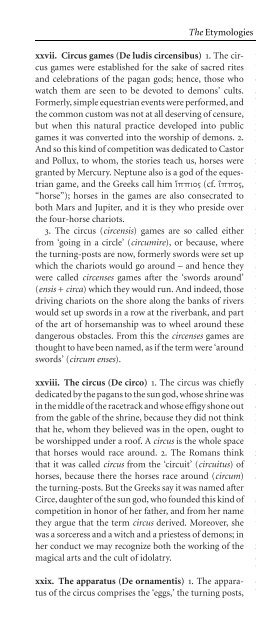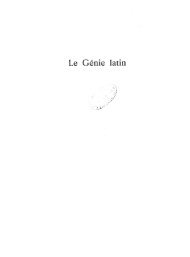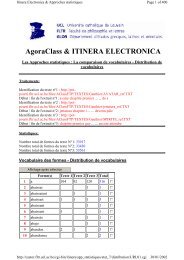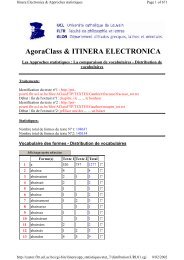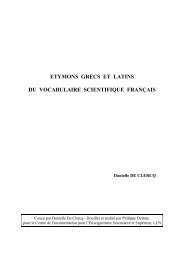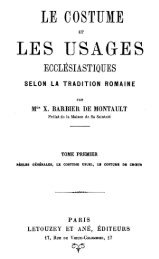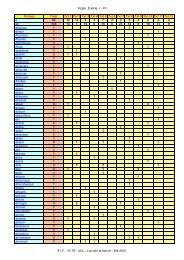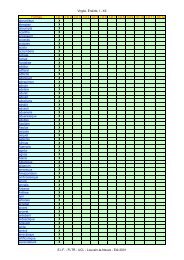The Etymologies of Isidore of Seville - Pot-pourri
The Etymologies of Isidore of Seville - Pot-pourri
The Etymologies of Isidore of Seville - Pot-pourri
You also want an ePaper? Increase the reach of your titles
YUMPU automatically turns print PDFs into web optimized ePapers that Google loves.
xxvii. Circus games (De ludis circensibus) 1. <strong>The</strong>circus<br />
games were established for the sake <strong>of</strong> sacred rites<br />
and celebrations <strong>of</strong> the pagan gods; hence, those who<br />
watch them are seen to be devoted to demons’ cults.<br />
Formerly, simple equestrian events were performed, and<br />
the common custom was not at all deserving <strong>of</strong> censure,<br />
but when this natural practice developed into public<br />
games it was converted into the worship <strong>of</strong> demons. 2.<br />
And sothiskind<strong>of</strong>competitionwas dedicated to Castor<br />
and Pollux, to whom, the stories teach us, horses were<br />
granted by Mercury. Neptune also is a god <strong>of</strong> the equestrian<br />
game, and the Greeks call him (cf. ,<br />
“horse”); horses in the games are also consecrated to<br />
both Mars and Jupiter, and it is they who preside over<br />
the four-horse chariots.<br />
3. <strong>The</strong>circus (circensis) games are so called either<br />
from ‘going in a circle’ (circumire), or because, where<br />
the turning-posts are now, formerly swords were set up<br />
which the chariots would go around – and hence they<br />
were called circenses games after the ‘swords around’<br />
(ensis + circa)which they would run. And indeed, those<br />
driving chariots on the shore along the banks <strong>of</strong> rivers<br />
would set up swords in a row at the riverbank, and part<br />
<strong>of</strong> the art <strong>of</strong> horsemanship was to wheel around these<br />
dangerous obstacles. From this the circenses games are<br />
thought to have been named, as if the term were ‘around<br />
swords’ (circum enses).<br />
xxviii. <strong>The</strong> circus (De circo) 1. <strong>The</strong>circus was chiefly<br />
dedicated by the pagans to the sun god, whose shrine was<br />
in the middle <strong>of</strong> the racetrack and whose effigy shone out<br />
from the gable <strong>of</strong> the shrine, because they did not think<br />
that he, whom they believed was in the open, ought to<br />
be worshipped under a ro<strong>of</strong>. A circus is the whole space<br />
that horses would race around. 2. <strong>The</strong>Romans think<br />
that it was called circus from the ‘circuit’ (circuitus) <strong>of</strong><br />
horses, because there the horses race around (circum)<br />
the turning-posts. But the Greeks say it was named after<br />
Circe, daughter <strong>of</strong> the sun god, who founded this kind <strong>of</strong><br />
competition in honor <strong>of</strong> her father, and from her name<br />
they argue that the term circus derived. Moreover, she<br />
was a sorceress and a witch and a priestess <strong>of</strong> demons; in<br />
her conduct we may recognize both the working <strong>of</strong> the<br />
magical arts and the cult <strong>of</strong> idolatry.<br />
xxix. <strong>The</strong> apparatus (De ornamentis) 1. <strong>The</strong>apparatus<br />
<strong>of</strong> the circus comprises the ‘eggs,’ the turning posts,<br />
<strong>The</strong> <strong>Etymologies</strong> XVIII.xxvii.1–xxxiii.1 367<br />
the obelisk, and the starting-gate. Some people say the<br />
‘eggs’ (i.e. objects used to mark the number <strong>of</strong> circuits<br />
<strong>of</strong> the chariots) are in honor <strong>of</strong> Pollux and Castor; these<br />
same people do not blush to believe that these two were<br />
begotten from an egg sired by Jupiter as a swan. 2. <strong>The</strong><br />
Romans claim that the circus games represent the first<br />
principles <strong>of</strong> the world, so that under this pretext they<br />
may excuse the superstitions <strong>of</strong> their own empty beliefs.<br />
xxx. <strong>The</strong> turning-posts (De metis) Properly by the<br />
term ‘turning-posts’ (meta) people mean to designate<br />
the end-point and boundary <strong>of</strong> the world, from the fact<br />
that the end is ‘measured out’ (emetiri)insomeway,or<br />
as a token <strong>of</strong> the rising and setting <strong>of</strong> the sun.<br />
xxxi. <strong>The</strong> obelisk (De obelisco) 1. Mesfres, king <strong>of</strong><br />
Egypt, is said to have been the first to make an obelisk,<br />
for the following reason. Because the Nile once had damaged<br />
Egypt with a violent flood, the indignant king, as if<br />
to exact a penalty from the river, shot an arrow into the<br />
water. Not long afterwards, seized by a serious illness,<br />
he lost his sight, and once his vision was restored after<br />
this blindness he consecrated two obelisks to the sun god.<br />
‘Obelisk’ (obeliscus)isthe name <strong>of</strong> the arrow that is set up<br />
in the middle <strong>of</strong> the circus because the sun runs through<br />
the middle <strong>of</strong> the world. 2. Moreover, the obelisk, set<br />
up in the midpoint <strong>of</strong> the space <strong>of</strong> the racetrack equidistant<br />
from the two turning-posts, represents the peak and<br />
summit <strong>of</strong> heaven, since the sun moves across it at the<br />
midpoint <strong>of</strong> the hours, equidistant from either end <strong>of</strong> its<br />
course. Set on top <strong>of</strong> the obelisk is a gilded object shaped<br />
like a flame, for the sun has an abundance <strong>of</strong> heat and<br />
fire within it.<br />
xxxii. <strong>The</strong> starting-gates (De carceribus) In the circus<br />
the places from which the horses are loosed are called<br />
starting-gates (carcer), for the same reason that prisons<br />
(carcer)inacity are so named – because, just as humans<br />
are condemned and imprisoned there, so horses are ‘confined’<br />
(coercere)here so that they may not start <strong>of</strong>f before<br />
the signal is given.<br />
xxxiii. Charioteers (De aurigis) 1.<strong>The</strong>art<strong>of</strong>the circus<br />
comprises the charioteer and the race, people on horseback<br />
or on foot. <strong>The</strong> charioteer (auriga) isproperlyso<br />
called because he ‘drives and guides’ (agere etregere), or<br />
because he ‘beats’ (ferire)theyokedhorses,foronewho


